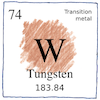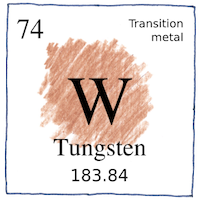Uppsala,
Bergara—Torbern Bergman,
Juan José Elhuyar,
Fausto Elhuyar
elements

|
Tungsten
In 1781, Carl Wilhelm Scheele and Torbern Bergman produced a new acid from calcium tungstate, which was called tungsten and is now called scheelite, naming the acid tungstic acid, and Bergman realized that the acid was the oxide of a new element, which he named tungsten, in Swedish “heavy stone.” In 1783, Juan José, a student of Bergman, and his brother Fausto Elhuyar found that wolframite contained tungstic acid and reduced the acid to the metallic element, which he named wolfram, which means “wolf foam,” after the mineral. originally named by Georgius Agricola, lupi spuma “wolf’s froth” for it rose as a foam during smelting of some tin ores and so reduced the amount of tin like a hungry wolf.
Atomic number 74
Tungsten carbide for cutting tools cemented with cobalt, tungsten for jewellery cemented with nickel, tungsten for high-speed steel for rocket nozzles for cutting metal at high speeds, tungsten for heat-resisting steel for engine valves and casings and for turbine blades, tungsten for plastic-mould steel, tungsten for piercing bullets and shrapnel, tungsten disulfide for high-temperature lubricants, tungsten for incandescent bulb filaments and fluorescent lighting electrodes, tungsten for microwave oven magnetrons, tungsten for the balls of ball-point pens, tungsten oxides for ceramic glazes, and tungsten for industrial catalysts.
Hard stuff
Heavier than lead, hard and brittle when polycrystalline, having the highest melting point, and resistant to chemical attacks, tungsten is used by some bacteria and archaea. Metalic tungsten is safe but the powder is explosive and some tungsten compounds are harmful to animal life. You know what your mother would say about that.



The chemical symbol for tungsten is W, for wolfram, the name chosen by the Elhuyar brothers and used in Europe. The name tungsten was not preferred because that was the original name of the mineral scheelite, CaWO4.
See also in The book of science:
Readings in wikipedia:
Other readings: